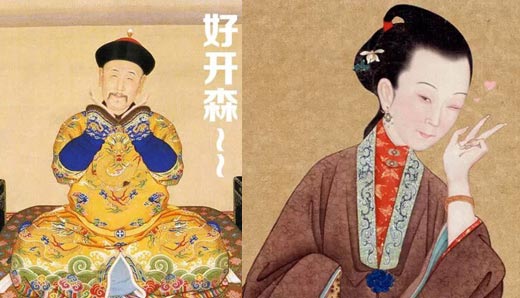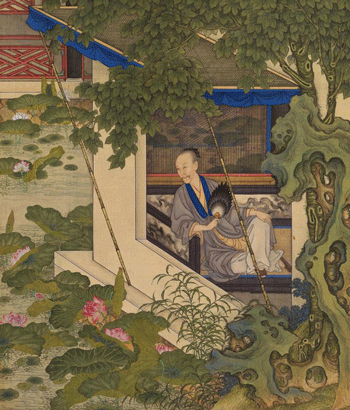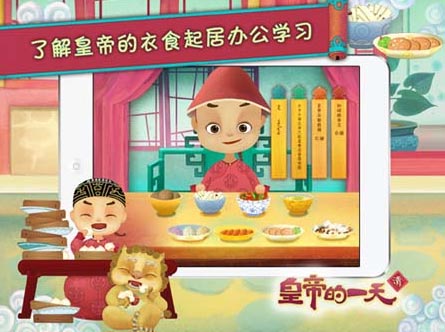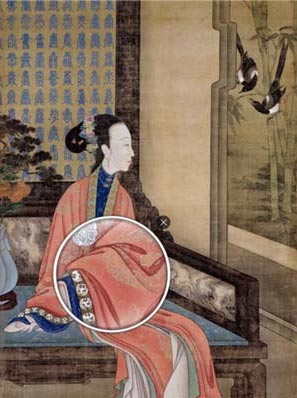
In the minds of most people, the Emperor and his concubines lived their lives solemnly.
 |
|
Emperor Kangxi of the Qing Dynasty (1644-1911) (pictured left) and concubines in the palace. [Photo/Agencies] |
With a smartphone apps, we see how lively and adorable they could have been.
 |
|
Depiction of Emperor Yongzheng and a courtesan in the palace by the Palace Museum. [Photo/Agencies] |
In the past, Emperors Yongzheng of the Qing Dynasty (1644-1911) was regarded as a serious figure who expressed his thoughts through composing poems and calligraphy.
 |
|
Actor Zhang Tielin portraying as Emperor Yongzheng (left) and one of the Emperor's calligraphy work. [Photo/Agencies] |
With Flash animations, we see that he also relaxed during his free time, as any person would, and did things that ordinary citizens would also do, like fanning himself to cool down or fishing in the pond.
 |
|
"Sometimes I just want to be a handsome man and be alone." [Flash by the Palace Museum] |
 |
|
A fan with characters written by Emperor Yongzheng (which literally translates to "I miss you"), is sold by the Palace Museum. [Photo/Agencies] |
In the past, historical tourist attraction sites offered exquisite, but not-so-practical souvenirs. More recently, they started selling merchandise that consumers could use in their daily lives, like fans with Emperor Yongzheng's calligraphy, or stringed Buddhist beads-inspired earphones.
 |
|
Stringed Buddhist beads-inspired earphones. [Photo/Taobao store of Palace Museum) |
These are just some of the latest creative cultural products released by the Palace Museum, which houses countless treasures and historic relics from Imperial China, and a place often associated with terms like royalty and class, something that's far from the lives of ordinary citizens.
Here are some behind the scenes stories on how these creative cultural products came to be.
 |
|
A screen capture from app A Day of an Emperor. [Photo/Agencies] |
Name: Liu Ningxing
Product: A Day of an Emperor
In Liu Ningxing's words, the Palace Museum has always tried to devise fun and creative ways to introduce China's traditional culture to the younger generation. "The Emperor carries a superior image as someone who can do anything he wants, but in fact, being an Emperor is a difficult job. The workload is heavy, and there are many restrictions," said Liu, a history major who started working at the Museum in 2004.
"Kids nowadays are all 'little emperors' in their homes. I wanted the 'little emperors' to know that a real Emperor can't do everything he wants, and that he still needs to study and needs to work.
"We wanted to create an app that's educational, visually pleasing and fun, something that kids would want to use but won't get addicted to," Liu added.
 |
|
A screen capture from app A Day of an Emperor. [Photo/Agencies] |
The app allows users to track the life of an Emperor in the Forbidden Palace, and see what he does at his resting palace, the office, the garden and recreational sites. There are tasks embedded in the app. Users can learn something about the Emperor through completing these, such as testing for poison with silver plates and piercing a willow leave from a distance with an arrow.
To Liu, the love of the Palace Museum is the driving force for his work. At the same time, he feels the weight of his mission and responsibility that comes from what he does.
"The seasons of the Forbidden Palace, the beauty of the architecture and relics, and all sorts of legends and stories... these are all part of our lives. In working with new media on an ancient subject, we have to learn about the Palace Museum and remain receptive to the Internet era at the same time,” Liu added.
 |
|
A screen capture from the app The Painting of 12 Yinzhen Beauties. [Photo/Agencies] |
Name: Zhuang Ying
Product: The Painting of 12 Yinzhen Beauties, The Forbidden City Daily, Qing Emperor Costumes
Zhuang Ying, who created The Painting of 12 Yinzhen Beauties, The Forbidden City Daily, Qing Emperor Costumes, says the contrast of traditional art museums spreading messages through the latest forms of media is very interesting.
When asked where creativity comes from, Zhuang provided "the background" as the answer.
"When I'm dining or commuting, I'm always thinking about my work in the back of my head. Sometimes an idea will also pop up at the sight of something unrelated to what I'm doing at the moment. We also discuss in groups to formulate ideas.
"I think my job is very 'in', and I work in an environment like no other," Zhuang added proudly.
"The architecture and collection at the Forbidden Palace is the essence of China's traditional culture, and a window for the world to get to know our culture. We have some of the top-rated experts in all fields working here, and I'm lucky to be a part of the team," said Zhuang.
The Painting of 12 Yinzhen Beauties was the first app introduced by The Palace Museum. It features 12 paintings of Chinese women, and the app walks users through the luxurious palace life of the Qing Dynasty. Users can also use a magnifying glass function to view the details of the paintings.
The Forbidden City Daily is a calendar that shows users one piece of ancient Chinese art, or a relic and its historical and cultural background, on a daily basis.
 |
|
A screen capture from the app The Night Revel of Han Xizai. [Photo/Agencies] |
Name: Li Qiong
Product: The Night Revel of Han Xizai
To Li Qiong, the mastermind behind the app The Night Revel of Han Xizai, "light" is a demanding term, for it takes a heavy workload to create something that's light and interesting.
"Interactive media only changed the channel the audience uses to learn history. It does not cut down on the effort on digging deep into facts and organizing information."
In the app The Night Revel of Han Xizai, a well-known painting created by Gu Hongzhong during the Tang Dynasty (AD 618-907) is introduced to the fullest. The descriptions of characters, furniture, artifacts and historical background are included with footnotes, a vast volume totaling more than 20,000 Chinese characters. Further details on the protagonist, aristocrat Han Xizai of the Tang Dynasty, are also provided. Furthermore, different versions of the painting, the legends surrounding the painting, details on its preservation, protection and exhibition at the Palace Museum are also mentioned.
"The information volume is huge, and we tried to divide and organize them into layers and showcase them through multimedia, including audio files," Li said.
The biggest selling point of this app lies in user interaction. Upon its first touch, the screen lights up dimly, as a light from a candle would do so at night. The user can slide across the screen for a virtual experience of what Han experienced that night. With another touch, characters in the painting come to life, as concubines start to perform music and dancers start to dance.
"On the basis of passing information accurately and thoroughly, we worked recreating the message of the original painting through this app," Li added.

Presented by Chinadaily.com.cn Registration Number: 10023870-7
Copyright © Ministry of Culture, P.R.China. All rights reserved